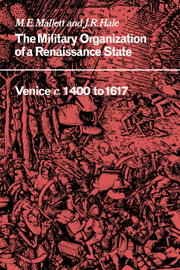Book contents
- Frontmatter
- Contents
- List of illustrations
- Acknowledgements
- References and abbreviations
- Map 1 The Terraferma in the fifteenth and sixteenth centuries
- Map 2 The empire da Mar
- PART I c. 1400 to 1508
- PART II 1509–1617
- 8 The historical role of the land forces 1509–1617
- 9 The wars
- 10 Government: policy, control and administration
- 11 The higher command
- 12 Manpower
- 13 Cavalry, infantry, artillery
- 14 Fortifications in the Terraferma
- 15 The defence of the maritime empire
- 16 The costs of defence and war
- Conclusion: the European context 1525–1617
- Appendix Infantry wages in the sixteenth century
- Select bibliography
- Index
14 - Fortifications in the Terraferma
Published online by Cambridge University Press: 22 October 2009
- Frontmatter
- Contents
- List of illustrations
- Acknowledgements
- References and abbreviations
- Map 1 The Terraferma in the fifteenth and sixteenth centuries
- Map 2 The empire da Mar
- PART I c. 1400 to 1508
- PART II 1509–1617
- 8 The historical role of the land forces 1509–1617
- 9 The wars
- 10 Government: policy, control and administration
- 11 The higher command
- 12 Manpower
- 13 Cavalry, infantry, artillery
- 14 Fortifications in the Terraferma
- 15 The defence of the maritime empire
- 16 The costs of defence and war
- Conclusion: the European context 1525–1617
- Appendix Infantry wages in the sixteenth century
- Select bibliography
- Index
Summary
The extensive programme of fortifying, or of modernizing older fortifications, that was carried out by the Venetian government from Agnadello to the beginning of the War of Gradisca has left its mark, in the most literal way, on the townscape of northern Italy from Bergamo to Palmanova. Its purpose was of the highest importance: to protect the major centres of population, to provide storm-shelters for the republic's armies, to discourage invasion. Fortifications and their garrisons provided the essential base from which to carry out Venice's on-the-whole successful policy of armed neutrality. This importance was attested by the creation of a special magistracy, that of the Provveditori alle Fortezze, in 1542 and its enlargement in 1580; by the appointment in 1587 of a ‘superintendent’ of all fortresses; by the prominence given to fortifications in the dispatches of commanders-in-chief, proveditors-general and the rectors of cities throughout the period; and by an expenditure of some 15,000 ducats a year up to 1540 and about 23,000 thereafter. It is true that fortifications da Mar received a proportion of these sums, but on the other hand central government funds contributed only one-third to the total cost of fortifications, the rest being borne by the cities concerned and by their surrounding territories.
In 1460 all rectors in the Terraferma had been ordered to have maps made of their jurisdictions. This paper knowledge, backed up by the practical understanding of distances and terrains acquired by those who owned land or had held office on the mainland, and through diplomatic wrangling over border disputes, meant that those discussing defence in the College or Senate had a reasonably clear mental image of the area to be defended.
- Type
- Chapter
- Information
- The Military Organisation of a Renaissance StateVenice c.1400 to 1617, pp. 409 - 428Publisher: Cambridge University PressPrint publication year: 1984



